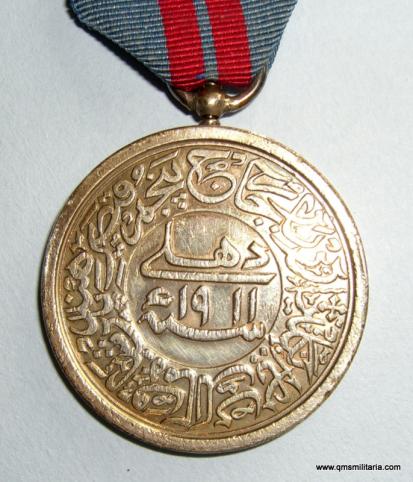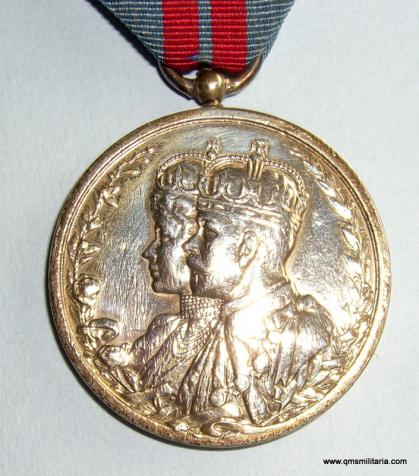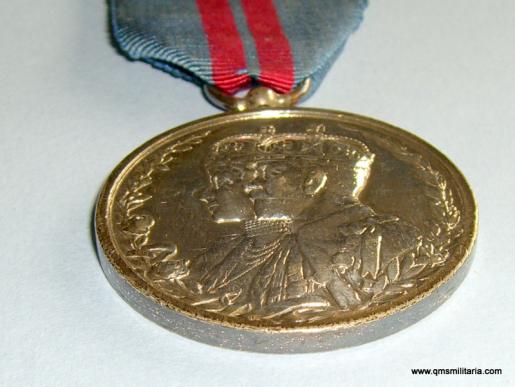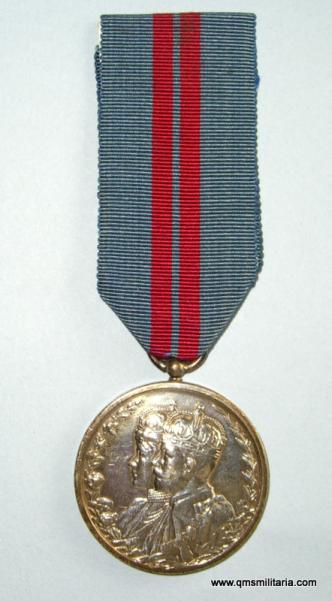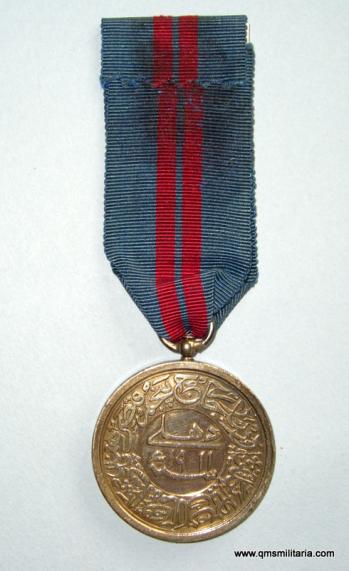Article 8 - Delhi Durbar Medal 1911 - King George V's visit to India
Unnamed as issued.
Obverse: The conjoined busts of King George V and Queen Mary, crowned and wearing the robes of state, and facing left. Encircling the effigies of Their Majesties are on the right a sprig of laurel, on the left a spray of roses, with ribbon entwined at the base of the design. The design has minor differences in the obverse from the smaller coronation medal, and unlike the coronation medal it does not have the designer's initials 'BM' on the ribbon at the base of the design.
Reverse: A central inscription in Persian: “Delhi 1911”, surrounded by an inscription in Persian characters which translated literally reads: “Darbar-i-George-i-panjum, Qaisar-i-Hind padshah u Malik-i-dayar-i-Ingliz” (The Durbar of George V, Emperor of India, Lord and Master of the British Lands).
Diameter: 39mm
Metal: Silver (circa 200 were issued in gold).
Ribbon: Garter blue with two central narrow crimson stripes (the same as that used for the Coronation Medal 1911).
Suspension: By a plain silver swivelling ring.
Designer: The obverse design is by Sir Bertram MacKennal, M.V.O., A.R.A.
Naming: Issued unnamed, but many of the regiments, such as the 13th Hussars and Northumberland Fusiliers present had them engraved or impressed for their personnel.
Following the precedent created by King Edward VII (Delhi Durbar Medal 1903), King George V sanctioned the award of a medal to commemorate the Delhi Durbar of 1911. However at the 1903 Durbar, the King did not attend but was represented by the Viceroy. By attending the Delhi Durbar in person, King George V became the first Emperor of India to visit his Indian peoples in person during his reign; and no reigning King of England had ever gone so far abroad since the days of King Richard I.
The Delhi Durbar Medal 1911, which is slightly larger than most medal issues, was struck at the Calcutta Mint; 200 in gold and circa 30,000 in silver. The gold medal was presented to senior officers of local governments and administrations, and the ruling chiefs. The silver medal was distributed not only to a proportion of those present at the Durbar, but to persons in every district throughout India. An eye witness has stated that in one regiment, the nominated recipients filed past a table on which there was a box of medals, marked "Do NOT TAKE MORE THAN ONE".
The 12th December 1911 was the most important day of the Durbar. It was held in a vast amphitheatre accommodating 62,000 spectators and the arena was occupied by some 20,000 troops. In the centre stood the beautiful Royal Pavilion, a graceful gold cupola supported by four white columns on a lofty marble dais. The day was perfect and the colour in the huge amphitheatre, packed with thousands of natives, quite amazing. Troops lined either side of the road inside the amphitheatre. The King and Queen arrived to the salute of 101 guns, wearing their crowns and robes and driving in an open carriage with a gold awning, two natives standing behind with the gold umbrella and fan, the Indian insignia of royalty. The National Anthem crashed out by the massed bands of 1,400 performers, followed by a flourish of silver trumpets announcing the Durbar was open.
After the Ruling Chiefs had done homage, Their Majesties slowly mounted the dais in the centre and seated themselves on the golden thrones in the Royal Pavilion in full view of all present, "remote but beneficent, raised above the multitude, but visible to all, flanked by radiant emblems of authority, guarded by glittering arrays of troops" in what must have been the most majestic assembly in the East. “It was a sight”, wrote a Times correspondent “which will remain indelibly engraved upon the memory”. A trumpet fanfare summoned the Heralds, who read the Proclamation announcing His Majesty's Coronation, first in English, and then in Urdu.
At the conclusion of the Proclamation the bands played the National Anthem, the troops presented arms, another salute of 101 guns by salvoes of batteries were fired, and the troops outside fired a feu-de-joie. The Herald and the trumpeters sounded a prolonged flourish and the Viceroy from his position on the steps below the King read His Majesty's announcement which had been awaited with so much eager anticipation. It announced the transfer of the seat of Government from Calcutta to the ancient capital Delhi. The 60,000 spectators and 20,000 troops present then gave three cheers for the King-Emperor followed by three cheers for the Queen-Empress, and their Majesties descended to their shamiana in rear of the dais and the Durbar ceremony, which had lasted about two hours, was closed.
The State visit of His Imperial Majesty King George V, to the Royal city of Delhi, was described as "the most brilliant, the most imposing, and the most gorgeous state ceremony the world has ever known".
For more information on the British Army recipients of the medal (about one in four of those present received a medal), see Duckers, P. (undated) "The Delhi Durbar Medal 1911 to the British Army", Squirrel Publishing, Shewsbury (ISBN 0 947604 04 9).
Research compiled by Mike Finchen.
Code: 56037

